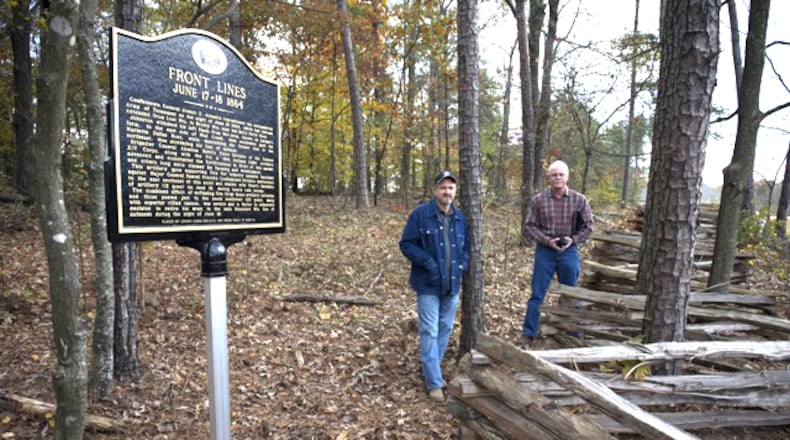Like hunters and fishermen, Jeff Wright and William Lathem have stories about the ones that got away. Not deer or fish, but a piece of history.
Take the case of the ghost railroad, chartered in 1859 and building west from Marietta when the Civil War broke out. Never completed, it was a long straight line of dirt back in the woods.
Wright and Lathem learned about it the day a developer was going into Cobb County for his zoning.
“We missed that one,” Wright said. “After properties come up for zoning, it’s hard to have leverage.”
Wright works as a bulk mail technician for the U.S. Postal Service and Lathem is a satellite communications expert. They’re active with the Civil War Roundtable of Cobb County, Marietta Confederate Cemetery Board and Sons of Confederate Veterans.
To developers and zoning officials, they’re the two guys with notebooks and old maps, trying to save rifle pits, artillery positions and skirmish lines from being built on.
RELATED: Where to find Civil War battlefields in metro Atlanta
PHOTOS: 5 Georgia sites where you can experience Civil War history
In June 1864, northwest Georgia lay in the path of Northern troops under Gen. William T. Sherman driving on Atlanta. Fighting between Federals and Confederates killed or wounded thousands. More than 150 years later, you can see the scars on the ground – a shallow trench, a series of mounds or a line of rocks.
Cobb County alone has dozens of them. “They’re all endangered,” Wright said.
“We contact (developers) early, once we know a property is up for sale and possibly going to be rezoned,” Lathem said. “We introduce ourselves and say, ‘You have a trench line or an artillery position on the property you’re looking to develop. It’s significant, and it’s an important part of American history. If you can arrange your site plan so it becomes part of a green space set-aside that the county wants, you preserve history.’”
So far, Wright and Lathem have helped save a Confederate artillery outpost known as French’s Hill at Stilesboro Road and Barrett Parkway, and earthworks where Sul Ross’ Texas Brigade of dismounted cavalry made a stand off Midway Road north of Dallas Highway.
They’ve helped preserve artillery positions near Kennesaw Due West and Acworth Due West roads, and a section of the Brushy Mountain Line of Confederate defenses near Interstate 75. They’re now working with a developer to set aside three acres of the Mud Creek Line – the site of a skirmish in the run-up to the Battle of Kennesaw Mountain – along Dallas Highway.
“These things were dug by common men, North and South, and it’s literally a footprint they left behind,” Wright said. “I think it’s a shame when these things are sitting in little one-, two- or five-acre spots, with the roar of traffic this way and the bright lights of a Target or a service station that way – all these people buzzing by and I don’t think they’re aware of what’s just off the road and how important it was.”
About the Author
The Latest
Featured



